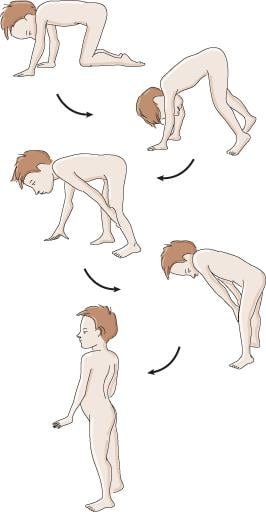If you’re preparing for the United States Medical Licensing Examination® (USMLE®) Step 1 exam, you might want to know which questions are most often missed by test-prep takers. Check out this example from Kaplan Medical, and read an expert explanation of the answer. Also check out all posts in this series.
This month’s stumper
A 3-year-old boy is brought to the physician because of difficulty walking up stairs and muscle fatigue. His parents have noted a progressive decline in his motor abilities over the last 5-6 months. He has also had delays in speech development. His temperature is 37 °C (98.6 °F), pulse is 104 beats per minute, respirations are 25 per minute, and blood pressure is 88/48 mm Hg.
On physical examination, the patient has enlargement in the muscles of his calves and a waddling gait. There is weakness in his proximal muscles and when arising from the floor, the patient uses his hands to push himself to an upright position. Laboratory studies show an elevated creatinine kinase.
The mode of inheritance of this boy’s disease is most similar to which of the following inherited diseases?
A. Cystic fibrosis.
B. Hemophilia A.
C. Huntington disease.
D. Fragile X syndrome.
E. Neurofibromatosis type l.
The correct answer is B.
Kaplan Medical explains why
The young boy is presenting with Duchenne muscular dystrophy (DMD):
- X-linked recessive disease (similar to hemophilia A).
- Mutation tracks to the dystrophin gene (DMD).
- Dystrophin mechanically reinforces the sarcolemma in striated muscle. Dystrophin deficiency initiates muscle fiber degeneration.
- Presents with proximal muscle weakness at 2 to 3 years old.
- Additional clinical fractures: dilated cardiomyopathy and scoliosis.
- Physical exam: pseudohypertrophy of the calf (fat infiltration = “pseudo”), waddling gait, and hyporeflexia.
- Gower’s sign: use hands/arms to push to an upright position (see image).
- Labs: increased creatinine kinase due to muscle fiber degradation.
- Prognosis: death by late teens to twenties from respiratory insufficiency and/or dilated cardiomyopathy.
The mode of inheritance of DMD is similar to that of hemophilia A, characterized by a deficiency in factor VIII. Patients with hemophilia experience spontaneous bleeding, particular into joint spaces and muscles. Diagnostic testing reveals an elevation in the partial thromboplastin time.
Why the other answers are wrong
Choice A: Cystic fibrosis is an autosomal recessive disease that is characterized by an abnormality in the cystic fibrosis transmembrane conductance regulator (CFTR). CFTR is a chloride channel required for normal Cl– movement across epithelia. The consequence of abnormal chloride transport is viscous secretions in the lungs, pancreas, intestines and reproductive tract.
Patients present with recurrent, frequent respiratory infections including pulmonary and sinus disease; failure to thrive; bulky, foul-smelling stools due to malabsorption secondary to pancreatic insufficiency; and infertility due to defective sperm transport.
Choice C: Huntington disease is an autosomal dominant inherited neurodegenerative disorder characterized by dementia and choreiform movements. The disease is caused by a trinucleotide repeat expansion in the huntingtin gene.
Choice D: Fragile-X syndrome is an X-linked dominant disorder caused by an expansion of a trinucleotide CGG repeat in the 5' untranslated region of the fragile X mental retardation 1 (FMR1) gene. The expansion causes a loss of function of the fragile X mental retardation protein. Males with this condition have characteristic physical features, particularly prominent in the adolescent, characterized by a long and narrow face with prominent forehead and chin, large ears, and testicular enlargement.
Choice E: Neurofibromatosis type I is an autosomal dominant disease that is characterized by multiple physical findings including café-au-lait macules, axillary freckling, Lisch nodules (iris hamartomas), and neurofibromas.
Tips to remember
- DMD is an X-linked recessive disease caused by a defect in the dystrophin gene.
- Presents with proximal muscle weakness and dilated cardiomyopathy.
- Physical exam reveals pseudohypertrophy of the calf and Gower’s sign, which is the use of a patient's hands/arms to push him to an upright position.
For more prep questions on USMLE Steps 1, 2 and 3, view other posts in this series.
The AMA and Kaplan have teamed up to support you in reaching your goal of passing the USMLE® or COMLEX-USA®. If you're looking for additional resources, Kaplan provides free access to tools for pre-clinical studies, including Kaplan’s Lecture Notes series, Integrated Vignettes, Shelf Prep and more.




